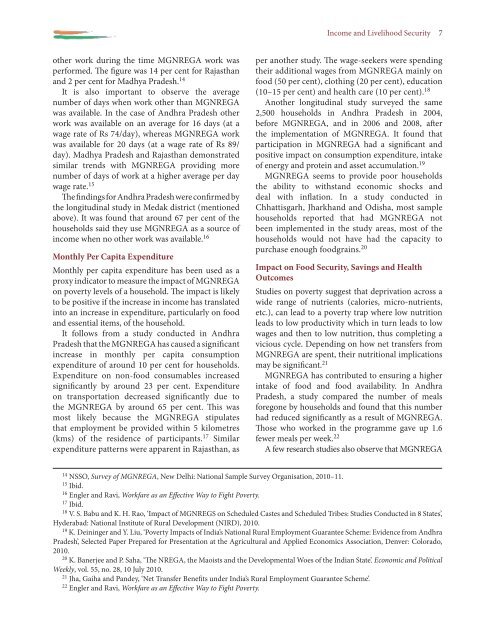MGNREGA_SAMEEKSHA
MGNREGA_SAMEEKSHA
MGNREGA_SAMEEKSHA
Create successful ePaper yourself
Turn your PDF publications into a flip-book with our unique Google optimized e-Paper software.
Income and Livelihood Security 7<br />
other work during the time <strong>MGNREGA</strong> work was<br />
performed. The figure was 14 per cent for Rajasthan<br />
and 2 per cent for Madhya Pradesh. 14<br />
It is also important to observe the average<br />
number of days when work other than <strong>MGNREGA</strong><br />
was available. In the case of Andhra Pradesh other<br />
work was available on an average for 16 days (at a<br />
wage rate of Rs 74/day), whereas <strong>MGNREGA</strong> work<br />
was available for 20 days (at a wage rate of Rs 89/<br />
day). Madhya Pradesh and Rajasthan demonstrated<br />
similar trends with <strong>MGNREGA</strong> providing more<br />
number of days of work at a higher average per day<br />
wage rate. 15<br />
The findings for Andhra Pradesh were confirmed by<br />
the longitudinal study in Medak district (mentioned<br />
above). It was found that around 67 per cent of the<br />
households said they use <strong>MGNREGA</strong> as a source of<br />
income when no other work was available. 16<br />
Monthly Per Capita Expenditure<br />
Monthly per capita expenditure has been used as a<br />
proxy indicator to measure the impact of <strong>MGNREGA</strong><br />
on poverty levels of a household. The impact is likely<br />
to be positive if the increase in income has translated<br />
into an increase in expenditure, particularly on food<br />
and essential items, of the household.<br />
It follows from a study conducted in Andhra<br />
Pradesh that the <strong>MGNREGA</strong> has caused a significant<br />
increase in monthly per capita consumption<br />
expenditure of around 10 per cent for households.<br />
Expenditure on non-food consumables increased<br />
significantly by around 23 per cent. Expenditure<br />
on transportation decreased significantly due to<br />
the <strong>MGNREGA</strong> by around 65 per cent. This was<br />
most likely because the <strong>MGNREGA</strong> stipulates<br />
that employment be provided within 5 kilometres<br />
(kms) of the residence of participants. 17 Similar<br />
expenditure patterns were apparent in Rajasthan, as<br />
per another study. The wage-seekers were spending<br />
their additional wages from <strong>MGNREGA</strong> mainly on<br />
food (50 per cent), clothing (20 per cent), education<br />
(10–15 per cent) and health care (10 per cent). 18<br />
Another longitudinal study surveyed the same<br />
2,500 households in Andhra Pradesh in 2004,<br />
before <strong>MGNREGA</strong>, and in 2006 and 2008, after<br />
the implementation of <strong>MGNREGA</strong>. It found that<br />
participation in <strong>MGNREGA</strong> had a significant and<br />
positive impact on consumption expenditure, intake<br />
of energy and protein and asset accumulation. 19<br />
<strong>MGNREGA</strong> seems to provide poor households<br />
the ability to withstand economic shocks and<br />
deal with inflation. In a study conducted in<br />
Chhattisgarh, Jharkhand and Odisha, most sample<br />
households reported that had <strong>MGNREGA</strong> not<br />
been implemented in the study areas, most of the<br />
households would not have had the capacity to<br />
purchase enough foodgrains. 20<br />
Impact on Food Security, Savings and Health<br />
Outcomes<br />
Studies on poverty suggest that deprivation across a<br />
wide range of nutrients (calories, micro-nutrients,<br />
etc.), can lead to a poverty trap where low nutrition<br />
leads to low productivity which in turn leads to low<br />
wages and then to low nutrition, thus completing a<br />
vicious cycle. Depending on how net transfers from<br />
<strong>MGNREGA</strong> are spent, their nutritional implications<br />
may be significant. 21<br />
<strong>MGNREGA</strong> has contributed to ensuring a higher<br />
intake of food and food availability. In Andhra<br />
Pradesh, a study compared the number of meals<br />
foregone by households and found that this number<br />
had reduced significantly as a result of <strong>MGNREGA</strong>.<br />
Those who worked in the programme gave up 1.6<br />
fewer meals per week. 22<br />
A few research studies also observe that <strong>MGNREGA</strong><br />
14<br />
NSSO, Survey of <strong>MGNREGA</strong>, New Delhi: National Sample Survey Organisation, 2010–11.<br />
15<br />
Ibid.<br />
16<br />
Engler and Ravi, Workfare as an Effective Way to Fight Poverty.<br />
17<br />
Ibid.<br />
18<br />
V. S. Babu and K. H. Rao, ‘Impact of MGNREGS on Scheduled Castes and Scheduled Tribes: Studies Conducted in 8 States’,<br />
Hyderabad: National Institute of Rural Development (NIRD), 2010.<br />
19<br />
K. Deininger and Y. Liu, ‘Poverty Impacts of India’s National Rural Employment Guarantee Scheme: Evidence from Andhra<br />
Pradesh’, Selected Paper Prepared for Presentation at the Agricultural and Applied Economics Association, Denver: Colorado,<br />
2010.<br />
20<br />
K. Banerjee and P. Saha, ‘The NREGA, the Maoists and the Developmental Woes of the Indian State’. Economic and Political<br />
Weekly, vol. 55, no. 28, 10 July 2010.<br />
21<br />
Jha, Gaiha and Pandey, ‘Net Transfer Benefits under India’s Rural Employment Guarantee Scheme’.<br />
22<br />
Engler and Ravi, Workfare as an Effective Way to Fight Poverty.


